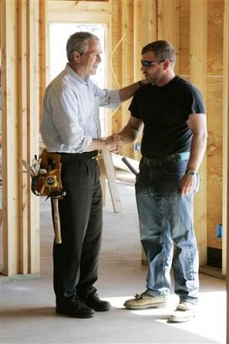Building Demolition Begins in New Orleans
 I feel better now... Caption: President Bush, left, wearing a tool belt, meets Michael Martin, 27, during a visit to a home being reconstructed after it was destroyed by Hurricane Katrina in Gautier, in the Mississippi gulf coast region, Wednesday, March 8, 2006. (AP Photo/Charles Dharapak).
I feel better now... Caption: President Bush, left, wearing a tool belt, meets Michael Martin, 27, during a visit to a home being reconstructed after it was destroyed by Hurricane Katrina in Gautier, in the Mississippi gulf coast region, Wednesday, March 8, 2006. (AP Photo/Charles Dharapak).The Architectural Record has a straightforward article on the topic. From the article:
On March 6 the U.S. Army Corps of Engineers began tearing down the first 125 homes in the city that had been identified as a "risk to public health and safety." These were slated to be destroyed by the end of the month, says John Fogarty, assistant area engineer tasked with debris removal and demolition for the U.S. Army Corps of Engineers. Structures in the first wave of demolition were located in public rights of way, and the majority were in the Lower Ninth Ward neighborhood, Fogarty said.
"Initially, 5,500 homes were red-tagged, and half of those were deemed at risk of imminent collapse," says Malana Joseph, a spokesperson for Mayor C. Ray Nagin's office. Demolition was stalled by a January civil suit, filed by residents who argued that the proposed demolition would violate their constitutional rights. A Federal Court ruling allowed the city to proceed with demolition, but only after following specific guidelines to notify owners. The delay won enough time for preservationists and the city's Office of Safety and Permits to re-evaluate structures. They cut the list in half.
"In the early days, there were all kinds of rumors going around saying 50,000 homes were going to be demolished," says Kevin Mercadel, program officer for the New Orleans office of the National Trust for Historic Preservation. Fears were justified, considering that initial assessments were conducted under emergency debris-removal contracts let by the Federal Emergency Management Agency (FEMA). Mercadel says the responsibility for assessing damaged properties then filtered down through numerous subcontracts, until it became difficult to determine who actually tagged properties, andwhat criteria they used. He adds that most inspectors did not have construction expertise. "They were red tagging buildings left and right and we couldn't figure out why."
Fearing that historic structures would be hastily destroyed, the New Orleans Preservation Resource Center (PRC) partnered with the National Trust for Historic Preservation to organize volunteer architects and structural engineers from across the country to re-evaluate properties. Mike Centineo, director of the city's Office of Safety and Permits, personally inspected 5,500 tagged building and reduced the citywide number to 1,900, Mercadel said. "We identified 369 red tagged in historic districts, and 199 of those can be saved."
Index Keywords: historic-preservation; New-Orleans



0 Comments:
Post a Comment
<< Home